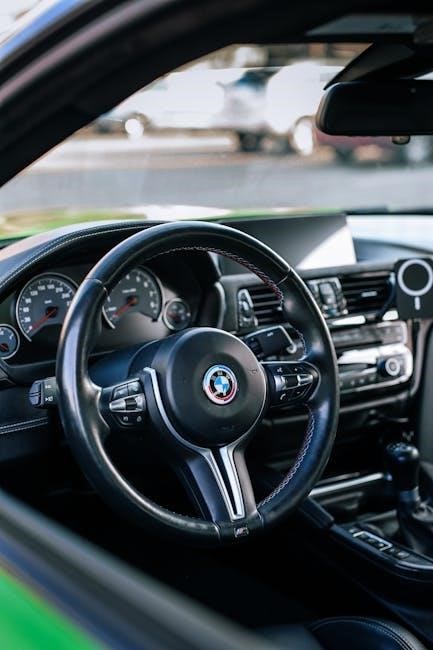The 3-Speed GM manual transmission is a classic, durable gearbox known for its simplicity and reliability in various GM vehicles, offering smooth shifting and enduring performance.
Overview of the 3-Speed Manual Transmission
The 3-Speed GM manual transmission is a straightforward, mechanically operated gearbox designed for simplicity and durability. It features a compact design with three forward gears and one reverse gear, making it suitable for a variety of applications. Known for its ease of use and reliability, this transmission was widely used in General Motors vehicles during its production run. The gear ratios are optimized for balanced performance, catering to both city driving and light hauling. Its mechanically operated system ensures minimal complexity, reducing the risk of mechanical failure. Over the years, the 3-Speed manual transmission has gained a reputation for being robust and requiring minimal maintenance, making it a favorite among classic car enthusiasts and those seeking a no-frills driving experience.
Historical Context of the GM 3-Speed Transmission
The GM 3-Speed manual transmission emerged during the mid-20th century, playing a pivotal role in the automotive industry. Introduced in the 1940s, it became a cornerstone in General Motors’ lineup, equipping iconic models like the Chevrolet Bel Air and GMC trucks. This gearbox was integral to GM’s success, offering drivers a reliable and efficient option. Its popularity peaked in the 1960s and 1970s, as manual transmissions were standard. The transmission’s enduring design and simplicity made it a favorite among drivers and mechanics alike. Over the decades, it remained largely unchanged, a testament to its robust engineering. Today, it is cherished by classic car enthusiasts, symbolizing a bygone era of automotive simplicity and durability.
Key Features of the 3-Speed GM Manual Transmission
The 3-Speed GM manual transmission is renowned for its durability, simplicity, and robust gearset, featuring a non-synchronized design and cast iron construction for reliability and strength.
Design and Engineering of the Transmission
The 3-Speed GM manual transmission was designed with a focus on durability and simplicity, featuring a cast iron case and a robust steel gearset. Its compact layout made it ideal for smaller GM vehicles, while the non-synchronized design kept production costs low. The transmission utilized a straightforward mechanical linkage system for shifting gears, ensuring reliability and ease of maintenance. Engineers prioritized strength and longevity, incorporating a reinforced casing and hardened gear teeth to withstand heavy use. This design approach contributed to its reputation as a dependable workhorse, making it a popular choice for both everyday driving and light-duty applications.
Gear Ratios and Their Applications
The 3-Speed GM manual transmission featured a set of gear ratios optimized for balanced performance and fuel efficiency. The first gear typically offered a ratio around 3.50:1, providing strong low-end torque for acceleration and hauling. Second gear, often at 2.00:1, allowed for smooth city driving and moderate speeds. Third gear, commonly 1.00:1 or slightly higher, was designed for highway cruising, reducing engine strain and enhancing fuel economy; These ratios were well-suited for both urban commutes and light-duty towing, making the transmission versatile across various driving conditions. The strategic gear spacing ensured drivers could easily find the right balance between power and efficiency, contributing to the transmission’s widespread popularity.

Performance and Capabilities
The 3-Speed GM manual transmission delivers robust acceleration and smooth shifting, making it ideal for both city driving and highway cruising with consistent reliability and control.
Acceleration and Fuel Efficiency
The 3-Speed GM manual transmission strikes a balance between acceleration and fuel efficiency, offering smooth gear engagement that optimizes power delivery. Its well-spaced gear ratios ensure responsive acceleration in city driving while maintaining efficient fuel consumption on highways. The transmission’s lightweight design and precise shifting mechanism contribute to better mileage, making it a practical choice for everyday use. Additionally, the low-end torque provided by the first gear makes it ideal for commuting in traffic, while the higher gears support steady speeds with minimal engine strain. This combination of performance and economy has made the 3-Speed GM manual transmission a reliable option for drivers seeking both power and efficiency.
Comparison with Other Manual Transmissions
The 3-Speed GM manual transmission stands out for its simplicity and reliability compared to other manual transmissions. While many modern manuals offer more gears, the 3-Speed’s straightforward design ensures durability and ease of maintenance. It competes closely with the 4-Speed manual, which is more common in sports cars, but the GM’s lighter weight and smoother shifting make it a preferred choice for everyday driving. Additionally, the 3-Speed GM transmission often outperforms competitors like the Ford Toploader in terms of low-end torque, making it ideal for city commutes. Its fuel efficiency is also notable, as the well-spaced gear ratios optimize mileage without sacrificing performance.

Maintenance and Repair
Regular fluid checks and gear lubrication ensure smooth operation. The 3-Speed GM manual transmission is known for its durability and simplicity, making DIY repairs manageable for enthusiasts.
Common Maintenance Tasks
Regular maintenance is essential for the 3-Speed GM manual transmission. This includes checking the transmission fluid level, replacing the filter, and lubricating the gear shafts. Additionally, inspecting the clutch pedal and ensuring proper alignment can prevent wear. Replacing worn synchronizers and bearings when necessary is also crucial. Proper lubrication with the specified transmission fluid ensures smooth gear engagement and prevents overheating. Following a routine maintenance schedule helps extend the life of the transmission and prevents costly repairs. These tasks are straightforward and can often be performed by DIY enthusiasts with basic mechanical skills.
DIY Repair Tips and Tricks
DIY repairs on the 3-Speed GM manual transmission can be cost-effective if approached methodically. Start by gathering a repair manual, tools, and genuine parts. Common fixes include replacing worn bearings, gaskets, and synchronizers. For gear grinding issues, adjust the clutch linkage and ensure proper alignment. Clean all components thoroughly before reassembly to prevent contamination. Use a torque wrench to secure bolts to factory specs. Apply the correct lubricant, such as GM-spec transmission fluid, to ensure smooth operation. Avoid overtightening, as this can damage gears. For beginners, consider consulting online forums or videos for visual guidance. Always test the transmission after repairs to ensure proper function.

Common Issues and Troubleshooting
Common issues include gear grinding, fluid leaks, and worn bearings. Troubleshooting involves checking fluid levels, inspecting seals, and replacing damaged components promptly to maintain performance.
Identifying and Addressing Transmission Problems
The 3-Speed GM manual transmission can exhibit issues like unusual noises, difficulty shifting gears, or fluid leaks. Identifying problems often starts with inspecting the transmission fluid level and condition. Clutch engagement and disengagement should be smooth; hesitation or grinding may indicate worn synchronizers or bearings. Leaks around the input or output shaft seals can lead to fluid loss, reducing lubrication and causing premature wear. Regular inspection of gaskets and seals is crucial. For DIY repairs, replacing seals or bearings can be manageable, but more complex issues like gear damage may require professional attention. Addressing problems early ensures optimal performance and extends the transmission’s lifespan.
Cost of Repairs and Replacement
The cost of repairing or replacing a 3-Speed GM manual transmission varies depending on the extent of damage. Minor repairs, such as replacing seals or bearings, can cost between $200 and $500. However, major issues requiring a complete overhaul or replacement can range from $1,000 to $3,000, depending on whether a rebuilt or new unit is used. Labor costs typically add $300 to $700, depending on the mechanic’s rates. DIY repair kits are available for those with mechanical skills, starting around $100 for basic parts. Consulting a professional for an accurate diagnosis and quote is recommended to avoid unexpected expenses.

Upgrades and Modifications
Upgrades for the 3-Speed GM manual transmission include gear ratio swaps, strengthened bearings, and aftermarket clutch kits to enhance performance and durability for both street and racing use.
Aftermarket Parts and Enhancements
The 3-Speed GM manual transmission can be enhanced with aftermarket parts, such as upgraded gear sets, heavy-duty bearings, and high-performance clutch kits. These modifications aim to improve durability and performance, catering to both enthusiasts and racers. Enhanced components are designed to withstand higher torque and stress, ensuring smoother shifting and prolonged lifespan. Aftermarket gear ratios can be tailored for specific applications, such as drag racing or off-road use, optimizing acceleration and torque delivery. Additionally, lightweight components and advanced materials can reduce wear and tear, making the transmission more efficient. Always consult experts to ensure compatibility and proper installation, as incorrect modifications can lead to mechanical issues. These enhancements allow drivers to unlock the full potential of their classic GM transmission while maintaining its iconic reliability and feel;
Performance Upgrades for Racing and Tuning
For racing and tuning, the 3-Speed GM manual transmission can be optimized with specialized upgrades. High-performance gear sets with shorter ratios enhance acceleration and torque delivery, making it ideal for competitive environments. Lightweight components, such as aluminum housings and carbon-fiber gears, reduce weight and improve power-to-weight ratio. Racing-specific clutches and bearings are designed to handle extreme stress, ensuring consistent performance under intense conditions. Additionally, aftermarket shift kits can refine gear changes, providing quicker and more precise shifting. These modifications not only boost performance but also maintain the transmission’s durability, making it a reliable choice for racers seeking to maximize their vehicle’s potential without compromising reliability. Proper tuning and setup are crucial to fully harness these upgrades and achieve peak performance on the track.
The 3-Speed GM manual transmission stands as a testament to durability and simplicity, offering reliable performance in both classic and modern applications, ensuring its lasting appeal and legacy.
Final Thoughts on the 3-Speed GM Manual Transmission
The 3-Speed GM manual transmission is a timeless piece of automotive engineering, cherished for its straightforward design, durability, and smooth operation. It has become a favorite among classic car enthusiasts and restorers, ensuring its legacy endures. Despite the rise of modern automatic and advanced manual transmissions, this gearbox remains a symbol of simplicity and reliability. Its availability in various GM models has made it accessible for both everyday driving and performance tuning. The 3-Speed GM manual transmission continues to be celebrated for its enduring performance and nostalgic appeal, making it a cornerstone in the history of automotive transmissions.
Future Prospects and Legacy
The 3-Speed GM manual transmission holds a special place in automotive history, symbolizing simplicity and reliability. While modern transmissions dominate, its legacy endures among classic car enthusiasts and restorers. Future prospects may see continued use in nostalgic projects, preserving its heritage. Its influence is evident in newer designs, ensuring its impact remains. The 3-Speed GM transmission’s timeless appeal guarantees its legacy as a cornerstone in automotive history, cherished for generations.
